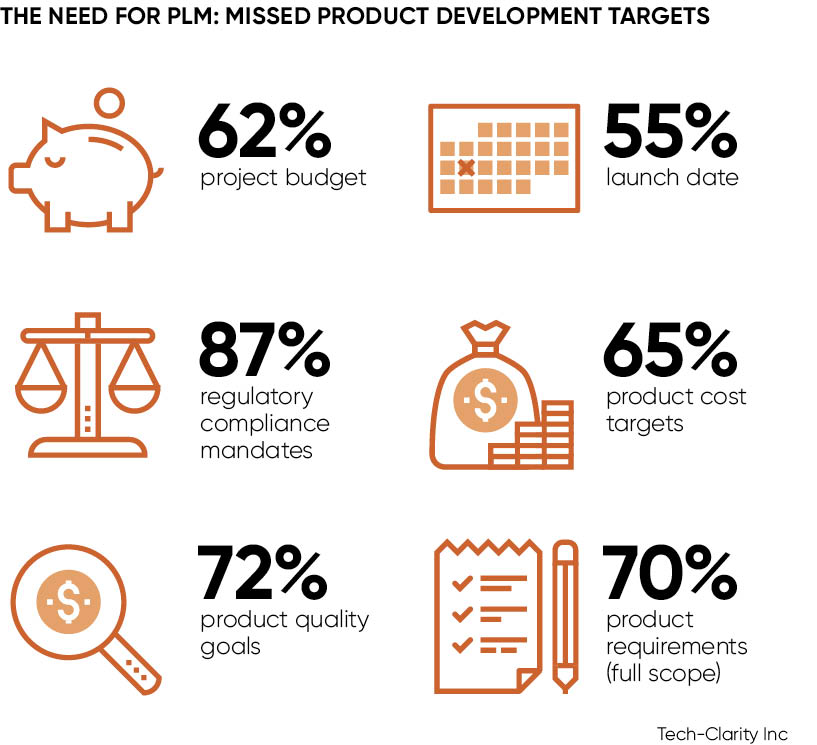PLM solutions have always been designed to offer businesses valuable visibility and cross-departmental status information, as products are developed. In doing so, traditional platforms have promised a route to greater efficiency and higher profits. These benefits remain the fundamental incentives for deploying PLM software, but the introduction of cloud-based systems has transformed access to these gains, rendering them easier, quicker and much less expensive to attain.
The shift to the cloud is also bringing the benefits of PLM platforms increasingly to the attention of a wider variety of businesses worldwide. Whereas once PLM platforms were primarily the preserve of very large companies, they are now being deployed and integrated by ambitious and innovative businesses of all sizes, and across a growing range of industry sectors.
Cloud computing dramatically cuts down the timescales and the upfront investments required to establish and integrate a PLM system that meets the particular needs of a specific business. Businesses are already seeing a real difference. Instead of having to make enterprise-wide deployments, they can simply identify a set of problems within one context and then build on their solutions to resolve issues in other areas.
With statistics from research firm Tech Clarity showing that 62 per cent of firms miss product project budgets, 72 per cent fail on quality goals and more than 50 per cent go past their planned launch date, the need is great for PLM. Choosing the most appropriate form of PLM software is crucial, but the potential benefits are as clear as they are tangible, with companies almost instantly able to cut costs, boost profits, meet product launch deadlines more reliably and innovate better.

Among the companies providing services and platforms in the PLM software space is Autodesk, whose clients include medium-sized as well as large-scale operators. Notably, its software is proving popular among small and medium-sized enterprises that need reliable PLM solutions, which offer clear efficiency gains and can be introduced within a matter of weeks rather than months.
Cloud-based PLM platforms are also proving hugely helpful for businesses that find themselves generating more and more data across an international workforce. In these contexts the benefits of improved visibility and the advantages of real-time management updates are particularly profound.
“We recognised that there must be a better way to store and access our data,” says Stuart Wells, head of product development at Astro Lighting, explaining why his company transitioned to using Autodesk’s cloud PLM platform.
“Initially, we started looking for an ERP [enterprise resource planning] system with the idea of building critical-path and workflow functionality. Early on in our search, we quickly realised that there wasn’t an ERP solution that addressed our needs. As a result, we widened our scope and started exploring other solutions.”
Astro Lighting has operating bases in the UK, United States and Singapore, and adds in the region of 200 new products to its lines every year. With the help of Autodesk’s Fusion Lifecycle software, the company has been able to redefine its product development processes within six months. Management at the lighting manufacturer can now access product information instantly and from anywhere via a single PLM dashboard. Processes have been made more efficient and products can be brought to market much more quickly.
The issue of improved visibility and information access throughout the product development process is particularly crucial for businesses, such as medical device maker P3 Medical, in industries which are stringently regulated.
“There are many steps to validating a medical device. Any chemical or component that goes into a medical device must have its components and biocompatibility traceability clearly displayed to an auditor. That’s very difficult when that data is on paper, in files and spreadsheets,” says Ian McEvoy, director and co-owner at P3 Medical, referring to the need for systematic management.
The core benefits underpinning the appeal of PLM software remain unchanged, but the shift to cloud computing has made the potential for success much clearer and more attainable
Mr McEvoy also emphasises the accessibility benefits that his company’s new cloud-based PLM platform offers. “It’s vitally important that I can access the system from anywhere in the world and know the data is secure. Cloud-based software allows me to do just that,” he says.
A growing variety of businesses are gleaning very considerable benefits at relatively little expense through cloud PLM. Another company to have done so is Mesa Labs, a maker of process validation and monitoring instruments, and consumables. Its priority concerns also include document management and the need to integrate two distinct legacy software systems.
“We were looking for a system that facilitated communication between departments. We wanted to manage the change order process without manual intervention. In addition, the system had to be easy to use and maintain,” says Gary Alcala, senior director of procurement at Mesa Labs.
“Today, with Fusion Lifecycle, the time taken to process a change order has been dramatically reduced from two weeks to two days. If necessary, we can push it through in two hours. With 15 to 35 change orders a week, that translates into a significant saving.”
The core benefits underpinning the appeal of PLM software remain unchanged, but the shift to cloud computing has made the potential for success much clearer and more attainable. Ultimately, the software enables businesses to gain a competitive advantage and do more with less. Thanks to the cloud, a growing variety of businesses can finally reap the benefits of PLM, at a lower cost and with greater confidence in seeing significant returns on their investments.
To learn more about how to make the most of cloud PLM in your business please visit www.autodeskfusionlifecycle.com
